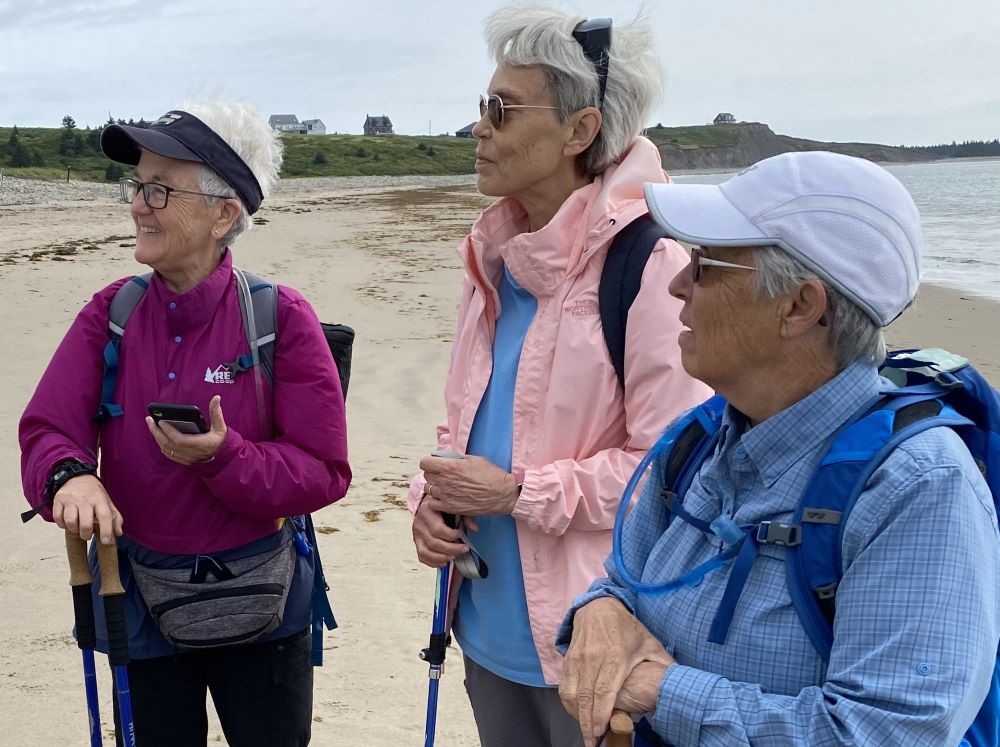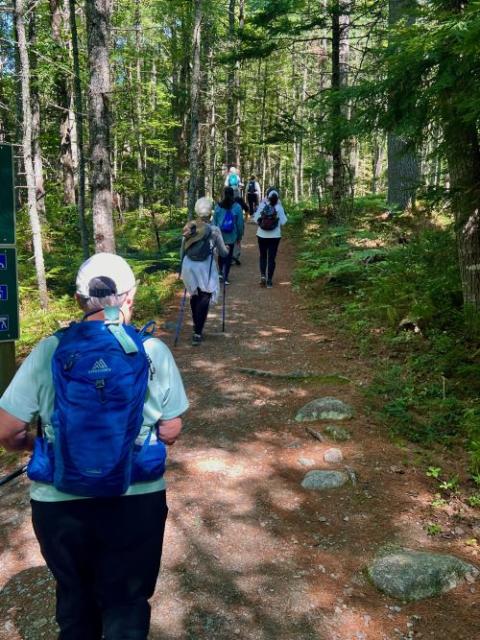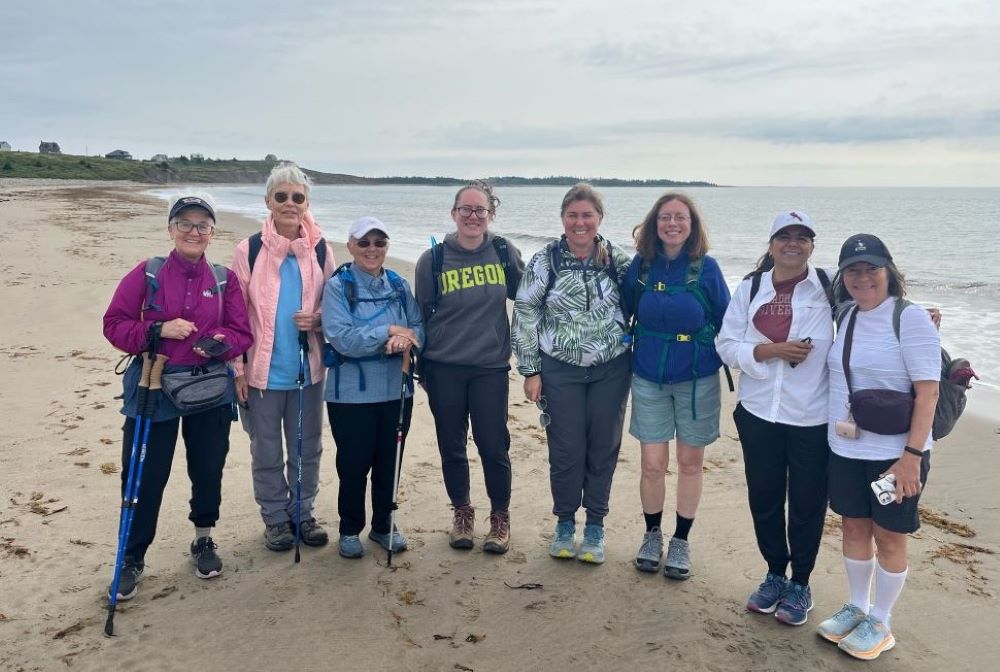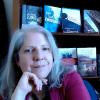
Religious of the Sacred Heart Sr. Mary Frohlich, center, is seen at Hirtle's Beach, Nova Scotia. She is with Sr. Diane Roche, left, and Sr. Jane O'Shaughnessy. Frolich is a hiking retreat leader and certified as a forest therapy guide. She retired from teaching at Chicago's Catholic Theological Union in 2020. (Ellyn Stewart)
Religious of the Sacred Heart Sr. Mary Frohlich is a retreat leader, spiritual director and emerita professor of spirituality. She retired from teaching at Chicago's Catholic Theological Union in 2020 and now lives in Cambridge, Massachusetts.
Beyond her identity as a scholar and author, and foremost in her spiritual life, Frohlich immerses herself in nature. She is a skilled hiking retreat leader, and certified as a forest therapy guide through the Association of Nature and Forest Therapy.
Her new book with Orbis Press is The Heart at the Heart of the World: Re-visioning the Sacred Heart for the Ecozoic Era. Her previous book, Breathed into Wholeness: Catholicity and Life in the Spirit, was part of the "Catholicity in an Evolving Universe" series published by Orbis Press. The series was edited by Franciscan Sr. Ilia Delio, who also wrote the forward.
Frohlich spoke to Global Sisters Report in Martin's River, Nova Scotia, where she was leading a hiking retreat. Participants included Religious of the Sacred Heart, their associates and teachers from Sacred Heart schools. She explained some startling implications of her new book — for example, how environmental degradation is a form of Christ's crucifixion — that will challenge readers to urgently and actively reframe our relationship with nature and the universe.
GSR: What were the origins of these hiking retreats?
Frohlich: One of our French sisters invited me to France in 2007. The activities included a hiking retreat which she and other Religious of the Sacred Heart were doing with young adults in the Alps. We hiked 12 to 15 miles a day, sometimes more. It inspired me. I thought, "Wow, we could do this."
I wanted to start mine in the Black Hills of South Dakota, [where I grew up], because that was the closest I could come to finding roots in a specific Earth-place. Religious of the Sacred Heart Sr. Diane Roche has partnered with me for most of them. While I was not trained as a forest therapy guide at that time, it was the same concept, inviting people into a somewhat wild environment and guiding them in attending to the creatures and to the place in a more contemplative way. Almost everyone who does this is deeply moved and changed spiritually.
GSR: Can you say more about what that region means to you?

Hikers make their way along Indian Path Trail in Nova Scotia. (Brooks Zitzmann)
Frohlich: [My eco-spiritual awakening] was at age 8, at Iron Creek Lake. At the time it was a secluded little place deep in the Black Hills. I can now say I was experiencing the love of God in and through the natural world. But at the time it was just this epiphany of the world itself. I didn't have the words to say it was God, because that wasn't my family's tradition. I wasn't even baptized until I was about 20.
That was a foundational vocational experience, but one that took me a long time to accept. Not in the sense that I rejected it per se, but it wasn't supported anywhere, by anybody. I didn't have the depth for a long time to grasp it.
GSR: Tell us more about your education and religious vocation.
Frohlich: When I was a student at Antioch College, between 1968 and 1973, it was a very wild time. Martin Luther King was killed, and then Robert Kennedy. There were the Kent State shootings, and the universities were all shut down. I started out majoring in biology, and regret changing majors.
I was a Carmelite first, from ages 26 to 30, but I didn't make first vows. Afterward I earned a Ph.D at the Catholic University of America, and then became a Sister of the Humility of Mary. Subsequently I struggled [with my vocation] and finally entered the Society of the Sacred Heart at about age 50. I made final vows at 62 — when others are thinking about retiring!
GSR: You've referred to your ecological consciousness developing in your 50s. What was different?
Frohlich: I think for a lot of people at midlife one shifts from fulfilling the expectations of the world and making a success of yourself, to "Who am I really?" It's not that you stop doing other things, but there is an inner shift toward asking deeper questions.
In the Jungian tradition they call it developing your weaker dimensions. I was always really strong on thinking and intuition. But in my 50s I began to develop my sensate and feeling sides through gardening, hiking, learning about the land and plants where I lived, and getting into the natural world.

A passing tourist took this photo at Hirtle's Beach, Nova Scotia. From left are Religious of the Sacred Heart Srs. Diane Roche, Mary Frohlich and Jane O'Shaughnessy, and Erin-Frances Reinhart, Brooks Zitzmann, Ellyn Stewart, Theresa Wiss and Sarah Cassidy. (Courtesy of Mary Frolich)
GSR: Did forest therapy inspire the genesis of this book?
Frohlich: Yes. I retired in 2020, so becoming a forest therapy guide became my pandemic thing. Forest therapy is not affiliated with any major religion, but it is a spirituality in the sense of a deep opening to connection with the creatures around one and to the environment, while being powerfully moved and learning from the physical, natural world.
It prepared me to write this book because it was a community of people who spoke and thought in a very different way about the natural environment, in a way of participation and communication and immersion and love. And I had really lacked that kind of community.
Also, members of my congregation kept asking, "Why don't you write about our spirituality?" I didn't have expertise in the Sacred Heart tradition, but over time I gained some. When I finally had the insight that the Heart of Christ is actually the heart of the world, this book is what came out.
However, the trouble with putting the phrase "the Sacred Heart" in the title is that it calls up a certain kind of piety. There are images associated with the Sacred Heart — like, being in this enclosed area in a church with candles — that are far from being out in green space connecting with nature.
GSR: What are you hoping will happen within us as we read this book?
Frohlich: I think it is an appeal to change one's mentality, very deeply. It is a recognition that the incarnation means there is a literal truth that Christ is present to us in and through all of these creatures and their intricate web of interconnections. Certainly, there's a uniqueness to his historical being. He lived as a human 2,000 years ago. But the fact that he was fully human means his presence is still flowing, coursing through all of this.
In one way it's not that radical, because there has always been the sacramental concept that God is present in some way in all things. And yet I think for most people that has been an abstract statement. If we really take that seriously and place it into the ecological context, if God is present in all things, what does that mean? It means that our relationship to the Earth and its creatures is our relationship to God.
GSR: Would you say that some of your implications are shocking?
Frohlich: The implications of my book are shocking when you think of what we're doing to the Earth. My insight is that this is the crucifixion of Christ. In a certain sense you could say that the crucifixion of Jesus was the prefiguration of the crucifixion that we are now giving to the Earth.
I agree with Thomas Berry's distinction between the technozoic and the ecozoic. He says the technozoic concept is that we can reconstruct the world through technology to suit our needs. Whereas in the ecozoic we use our gifts and intelligence to more fully participate and to bring abundance of life within the community of earth creatures.
Teilhard de Chardin is an important figure in the roots of this book as well. He precedes me in this concept of the heart at the heart of the world, including specifically the Sacred Heart. His mother raised him with a deep devotion to the Sacred Heart. When he was a stretcher bearer during the bloodiest battles of World War I, he had these literal visions of the Christic Heart at the heart of the world.
Advertisement
GSR: Do you feel that you are launching a school of thought? And if so, how would you define it?
Frohlich: Time will tell! I'm very aware that I stand on the shoulders of others, [and] we've mentioned some of them. I think the relative uniqueness of my book is the Sacred Heart connection, because that gives it theological as well as spiritual depth. It is centered in Christology, which gives it the theological dimension of who Christ is, and who Christ is in the world. And again, this particular Heart aspect hasn't been developed, in depth, by anybody else since Teilhard. So there's that freshness to it.
I do hope it will inspire other people. I'll bet there are young theologians out there who could really run with this! I'm very aware that the concepts all need much more exploration and development.
GSR: Was this a book that taught you what it was as you wrote it? Or, or did you carry it in your heart and then express it?
Frohlich: Probably some of both. For quite a few years I had been developing the connection with the natural world, the immersion, and even the retreats that guided people. But I really hadn't connected it to the Sacred Heart. So when that light bulb went on, it became doubly what I needed to write, because it was for my tribe of the Sacred Heart in that sense, and in a far greater sense to meet a crucial contemporary need of the people and creatures of the Earth.







